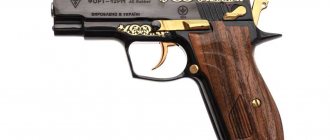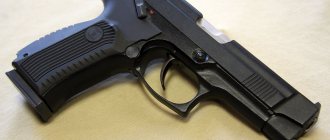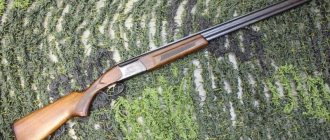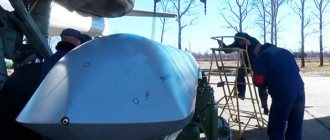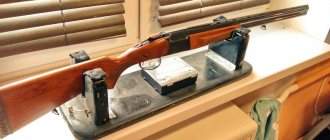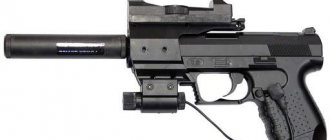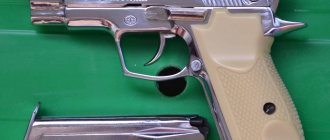Home | Weapons | Pistols | Germany | Walther PPQ M2
The Walther PPQ M2 pistol is available in 9x19 and .40 S&W calibers. Instead of the magazine release lever familiar to previous modern Walters, the PPQ M2 is equipped with a conventional push-button latch located at the base of the trigger guard. In the front part of the polymer frame there are Picatinny rails, allowing you to install a laser laser or tactical flashlight on a weapon.
The automation works according to the scheme of using recoil with a short barrel stroke. Locking is carried out using the lowering breech of the barrel, which enters with its rectangular protrusion located above the chamber into the window of the bolt-casing for ejecting spent cartridges. The reduction occurs when the bevel of the lower tide of the barrel breech interacts with the protrusion of the frame.
The bolt-casing and barrel are coated with Tenifer, which increases mechanical strength and is resistant to corrosion. The trigger with a pre-cocked striker has a smooth trigger stroke with a force of 2.3 kg and a short return stroke.
The PPQ M2 is equipped with interchangeable back parts of the handle of different sizes, which allows the gun owner to adjust the handle to his hand, obtaining maximum grip comfort and shooting accuracy. The handle itself has a comfortable ergonomic shape with grooves for fingers. The Walther PPQ M2 pistol is equipped with a chamber presence indicator and a double-sided bolt stop with long levers. The shutter-casing has both rear and front large inclined notches.
Safety in handling is ensured by automatic trigger and firing pin safety devices, protecting against accidental discharge when the weapon is dropped. The Walther PPQ M2 low-profile sights consist of an interchangeable, non-adjustable front sight and an adjustable rear sight that feature three white dots for low-light shooting.
In addition to the basic Walther PPQ M2 model, there is a PPQ M2 5″ version with an extended 127 mm barrel, a compact version with a 117 mm long barrel and a PPQ M2 NAVY version with an extended barrel threaded on the muzzle for installing a silencer, as well as a PPQ 45 under .45 ACP cartridge. For an additional fee, the gun owner can install a metal front and rear sight with glowing tritium inserts.
History of creation
The 9 mm Walther PPK pistol was created on the basis of the Model PP pistol by Carl Walther GmbH Sportwaffen, released in 1929. Since 1908, Walther had produced several semi-automatic pistols that had a reputation for being well made and reliable, but the PP was an important step in a new direction.
As the name suggests, it was designed to be carried by police officers and was based on the differences in attitudes towards police weapons across continents. While Americans preferred relatively large-caliber revolvers, Europeans chose smaller, lighter pistols more suitable for densely populated cities.
The PP model was one of the first pistols to be made from alloy rather than steel, allowing for significant weight savings. This solution was appreciated by experts, but the police needed a smaller version that could be carried discreetly by plainclothes officers and undercover detectives.
The result was the Walter PPK (Polizei Pistole Kriminal or Police Detective Pistol).
Links[edit]
- RUAG pistol and submachine gun Ammunition 9x19 caliber
- "Smith & Wesson Begins Shipping Governor's Revolver and Walther PPQ Pistol". AmmoLand.com
. Retrieved July 14, 2011. - ^ abcdefghij Presentation of Walther PPQ at the German Police Academy (in German)
- Walther PPQ Blasting Drawing and Parts List
- Comparison shown for first generation Walther P99, third generation Walther P99 and Walther PPQ.
- Personal semi-automatic pistol RAD
- "PPQ Magazine Question". waltherforums.com
. Retrieved August 15, 2011. - ^ ab "Karl Walter Sportwaffen". Retrieved December 5, 2014.
- ^ abcd Walther Protection Catalog, 2011
- ^ abcdef Safety and operating instructions WALTHER PPQ pistol
- "TR\" Pistolen im Kaliber 9 mm x 19\", stand: January 2008" . Retrieved December 5, 2014.
- ^a b Kasler, 137
- Kokalis, 321
- Walther 2016 pistol pages Catalog 4 and 7
- "About Walter". Walter Arms
. Retrieved December 5, 2014. - Gun Review: Walther PPQ M2 (5" Slide) Joe Grine July 17, 2014
- "Walther PPQ M2 .45 ACP". Walter Arms
. Retrieved August 21, 2015. - "Walther PPQ 45 arrives!" . guns.com
. Retrieved August 21, 2015. - ^ ab "WALTHER PPQ M2 for Taiwan" (PDF). Retrieved November 9, 2015.
general description
The Walther PPK pistol is a semi-automatic blowback pistol. Today, PPK pistols are manufactured by Carl Walther GmbH Sportwaffen in Germany or under license from Walther in France and the USA. These pistols have an exposed hammer, a double-action trigger, and a fixed barrel that also guides the pistol's recoil spring. The store is single-row.
Product development[edit]
P99 RAD is manufactured under license in Poland.
P99Q police duty pistol.
Walther PPQ is not a completely new design. It shares its engineering principles and basic characteristics with the Walther P99QA variant of the P99 pistol, which was introduced in 2000. [5] However, unlike the P99QA, which used a partially cocked striker (like the Glock), the PPQ uses a fully cocked striker. There were many other changes to the design that were not seen on the Walther P99QA, such as a redesigned grip, trigger guard, and front (larger) serrated bolt coming together in 2008 on the Walther P99 RAD, a variant of the P99. manufactured in Poland and sold as a military pistol [6] and a Walther P99Q police pistol.
Through product development, PPQ maintains compatibility with both P99 scopes and second-generation P99 magazines and other accessories. [7] [8]
The PPQ's main innovation over the P99QA, P99 RAD, and P99Q is its Quick Defense trigger. [3]
Device and design features
Possessing compactness and serious stopping power, the PPK instantly became popular with European police. But why? What made the Walther PPK so successful that it continues to be produced even 90 years after its introduction?
The answer lies in its design, much of which was taken from the Walther PP. It combines a very complex mechanism with a very simple execution.
The weapon works by having the top of the weapon act as a bolt that is pulled back by the powder gases when fired. This activates a mechanism that ejects the cartridge case and loads the next cartridge from the magazine into the chamber.
The PPK has what is known as a blowback design, in which the barrel is mounted to the pistol frame and acts as a guide for the recoil spring. This not only simplifies the mechanism, but also makes the PPK more accurate than comparable tilt-barrel models. Unfortunately, it also causes the weapon to bounce more when fired because the mechanism doesn't absorb much of the recoil.
Because the PPK was designed for concealed carry in situations where a holster must be abandoned in favor of a pocket or belt, the Walther PPK is designed with a strong focus on safety. Its streamlined design prevented anything from snagging on clothing, and the mechanism had a number of features to prevent accidental firing, even with a cartridge in the chamber.
The firing of the safety is blocked by the firing pin, so it cannot reach the cartridge primer. The safety then rotates the steel lock behind the firing pin to prevent the hammer from striking it, and if the hammer is cocked, the safety “releases” it safely.
Another safety feature is the signal pin. It is a small metal pin that protrudes from the rear of the pistol's slide when the chamber is loaded.
Walter PP and PPK
The PPK is in many ways similar to its predecessor, but has a number of differences and improvements. The PPK is 0.6 inches shorter than the PP and has plastic grips on the pistol grip. The PPK also has a shorter handle and the magazine holds one less round.
Principle of operation
The main feature that really set the PPK apart when it was introduced was that it was the first successful single/double action trigger pistol to come to market. This means that the PPK combines two basic gun operating principles into one pistol.
Simply put, with single action the hammer must be cocked before each shot. Pulling the trigger only releases the hammer. In a pistol with a double-action trigger, pulling the trigger both cocks and releases the hammer when the pistol is fired. Each time the trigger is pulled, the hammer is pulled back again.
Each subsequent press releases the hammer as if it were a single action, repeating the cycle. This made PPK much faster and easier to use when needed in a hurry. In addition, by combining these two operating principles, the PPK added another safety factor: the first pull of the trigger required significant force, which reduced the likelihood of accidental operation.
Specifications
| Caliber | 7.65 Browning/9mm Short |
| Gun length | 154 mm |
| Barrel length | 83 mm |
| Height | 99 mm |
| Width | 30 mm |
| Curb weight | 568 grams |
| Magazine capacity | 7 or 6 rounds |
Advantages and disadvantages
Incredibly compact: the weapon is suitable for concealed carry.
Light weight. The weight of the unloaded pistol is only 568 grams.
High stopping power
High return. Due to the use of a powerful cartridge and a non-fixed barrel, the weapon has serious toss when fired.
Options [edit]
PPQ Tactical Navy
is a variant that has a firing mechanism that has been modified to operate in and near water. A non-standard hole in the firing pin channel provides sufficient water displacement if the weapon is completely flooded with water. The hydraulic resistance is compensated by a stronger striker spring. In addition, special guides reduce hydraulic resistance when the striker moves forward. These pistols come with a standard staggered magazine column and a second magazine with a +2 base plate that adds 2 rounds to magazine capacity
PPQ Tactical Navy SD
same pistol as the PPQ Tactical Navy with the addition of a 118 mm (4.6 in) long special barrel with a threaded muzzle for mounting a suppressor.
PPQ First Edition
is an option on the market in the United States. These pistols are marked PPQ First Edition on the slide and have a custom 118 mm (4.6 in) barrel with a threaded muzzle to accept a suppressor and fixed metal three-dot tritium night sights. Further, these pistols come with a standard staggered magazine column, a second magazine with a +2 baseplate that adds 2 rounds to magazine capacity, and a set of standard polymer looks that use afterglow paint contrast enhancements instead of tritium inserts.
M2 series[edit]
PPQ M2
represents an option presented at the 2013 Show shot by the newly formed Walther Arms Inc. It has the same features as the standard PPQ with the only exception that the ambidextrous magazine release levers included at the bottom of the trigger guard have been omitted and replaced with a thumb release located behind the bottom of the trigger guard. [15] For left-handers, the magazine release button is reversible. Additionally, PPQ M2 magazines are not compatible with original PPQ magazines.
PPQ M2 Navy SD
was introduced in 2014 and is a 9×19mm Parabellum variant that has a firing mechanism that has been modified for operations in and near water. A non-standard hole in the firing pin channel provides sufficient water displacement if the weapon is completely flooded with water. The hydraulic resistance is compensated by a stronger striker spring. In addition, special guides reduce hydraulic resistance when the striker moves forward. It has a special 118 mm (4.6 in) barrel with a threaded muzzle to accommodate a suppressor. These pistols come with a standard staggered magazine column and a second magazine with a +2 baseplate that adds 2 rounds to magazine capacity.
PPQ M2 5″ Sport
was introduced in 2014 and is a PPQ sport shooting oriented variant offered in 9×19mm Parabellum and .40 S&W chamberings featuring a longer 127 mm (5.0 in) barrel and bolt assembly that offers 183 mm. (7.2 in) sight line. The elongated slide has two rows of three oval-shaped holes, lightening cut off at the end of the muzzle of the slide. c Sports models PPQ M2 5″ have a total length of 206 mm (8.1 in). The PPQ M2 Sport 9×19mm Parabellum weighs 657 g (23.2 oz) (empty), and the PPQ M2 Sport .40 S&W weighs 670 g (24 oz) (empty).[16]
In August 2015, Walther announced the PPQ M2 in .45 ACP, due to be available in October 2015. [17] The pistol was enlarged to accommodate .45 ACP cartridges, which also resulted in a heavier pistol. The thicker, longer bolt extends slightly higher up the bore to the end of the extended barrel. Unlike the PPQ 9x19mm Parabellum and .40 S&W models, the PPQ M2 .45 ACP has polygonal rifling. The ejection port has also been redesigned to accommodate .45 ACP shells. [18]
Training options[edit]
PPQ Simunition FX
Available in a shooting version 9mm FX Force-on-Force System Paintballs made by Simunition.
PPQ Red Gun
is a pistol identical in design and operating principle to the actual service weapon.
All functional elements, dimensions, weight and characteristics of the trigger are the same. However, PPQ Red Guns do not allow you to load or fire ammunition. The PPQ Blue Pistol
is a plastic pistol designed for training holster.
Post-war use
After the war, the PPK was adopted by many intelligence agencies, including the British MI5 and MI6, the German BND, the French SDECE, the Israeli Mossad and the Swiss Intelligence and Security Service. Even Communist China's Intel service and East Germany's Stasi used PPK clones. It also served as the model for the Soviet Makarov, the Hungarian FEG PA-63, the Polish P-64, the American Accu-Tek AT-380 II and the Argentine Bersa Thunder 380.
However, the Walther company itself fell on hard times, as the Allies banned Germany from producing weapons, and the original plant ended up in the Soviet occupation zone. Using some salvaged design documents as collateral, the company settled again in Ulm and survived by licensing PPK production to the French company Manufacture de Machines du Haut-Rhin (Manurhin) until Walther resumed production in Germany in 1957.
Despite this setback, PPK remained fantastically popular with the public, especially in America. Many returning American soldiers smuggled in PPK that they had acquired in one way or another. In fact, so many of them made it to the States that a cottage industry emerged in the market for these "liberated" PPKs and lasted until the 1960s.
Many PPKs had to sneak into the US through some legal trickery because in 1968 the US government passed a law prohibiting small pistols from being imported into the country unless they met certain conditions. This ban kept PPK out of US stores until Walther came up with the PPK/S variant to get around the ban. Walther mated the PP frame to the PPK slide and barrel to make it 1.8 oz (51 g) heavier and 0.2 in (5.1 mm) taller. Walther then added the letter S to the model designation, which stands for "Sport", and overcame limitations in the company's largest market.
In 1983, Walther began manufacturing the PPK and its variant PPK/S in the United States under license first from Ranger Manufacturing and then from Smith and Wesson. The latter featured minor changes such as a longer "beavertail" to protect the shooter's hand during bolt movement and a modified chamber to prevent the weapon from jamming with the introduction of new hollow point ammunition.
Users[edit]
- Republic of China (Taiwan): Taiwan National Police Agency [19] In 2015, the PPQ M2 (M2 combined with M1 fully ambidextrous paddle magazine releases) was selected through testing/bidding to replace the Smith & Wesson 5904 and 6904 as Taiwan's police force. standard issued pistol. The testing/bidding process included Glock 19, Sig Sauer P250, Taurus PT92 and PPQ M2 pistols. Glock and PPQ entered phase two, the firing test, and both passed the required 3,600 rounds without malfunction and the 1,200 round accuracy test. During the bidding phase, Walther won a government contract to supply 49,600 PPQ M2 pistols over 5 years. [19]
Walter P22
Polymers were used for the body of the Walter 22 sports pistol; the casing and bolt remained steel. To fit the athlete, removable pads and sights are used. The weapon is a copy of the Model 99, but is shorter and uses a shorter 22 LongRifle cartridge. The combat rate of fire is within 40 rounds per minute, taking into account the reloading of a box magazine with 10 rounds. The weapon range has been increased to 350 m (maximum) and 50 m (aiming).
Walter P22 design
The Standard model has an 8.7 cm barrel, the Target has a 12.7 cm barrel. The Umarex company produces traumatic and gas modifications of weapons - P22T chambered for 10 x 22 m T and P22 chambered for 9 mm R.A., respectively.
Notes
- ↑ A. B. Zhuk. Encyclopedia of small arms: revolvers, pistols, rifles, submachine guns, machine guns. M., AST Publishing House LLC, Voenizdat, 2002. p.312
- ↑ Classics at a price. Walther PP // magazine "Master Gun", No. 8 (101), August 2005, pp. 70-75
- Interarms Walther PPK/S American pistol // “American Rifleman” magazine, November 1980
- A. B. Zhuk. Encyclopedia of small arms: revolvers, pistols, rifles, submachine guns, machine guns. M., AST Publishing House LLC, Voenizdat, 2002. pp. 305, 306
- ↑ Hungarian pistols // “Arms and Hunting” magazine, No. 9, 2008
- Unknown Makarov. // "Weapons" magazine, No. 10, 2004 (special issue)
- ↑ V. A. Kashevsky. Infantry weapons of the Second World War. Minsk, Harvest LLC, 2004. p.87-89
- Walther PP // Chris Shant. Infantry weapons: encyclopedia of small arms. / lane from English M., "Omega", 2004. p.27
- Walther for the police of the Shah of Iran // “Master Gun” magazine, No. 6 (87), June 2004. pp. 70-73
- Fritz the Great of Zella-Melis (part 2) // “Master Gun” magazine, No. 2 (143), February 2009. pp. 34-44
- Tom Ferguson. Modern Law Enforcement Weapons & Tactics. 2nd edition. Iola, DBI Books, Inc. 1991. pages 45-47

